Critique Submissions‚ October, 2000
This page contains submissions made during October, 2000 from photographers who wished to have their photographs reviewed by the publisher of this site,Michael Reichmann.For additional details see theCritique / Contestpage.
The October winner of a complimentary 1-year subscription to theLuminous Landscape Video JournalwasFred Lord.
Fred Lord

Colorado’s Gore Range 9 miles north of Silverthorne, Summit County
Fred Lord
flord@integerdenver.com
Fuji GSW690 – 1/60 sec. @ F/9 w/polarizer handheld
Fuji Superia Negative Film
8:00 AM , Saturday, September 30, 2000
Shot from Ute Pass looking WSW. Scanned on Dai-Nippon "Screen" Drum Scanner. I had scouted the location several times previously but in the afternoon and had found it to be less than perfect. Finally, we had some snow on this particular Friday but the aspens were still acceptable so I scouted it that evening with my wife. We felt it had some real potential for an early morning shot. I managed to get up at dawn the next AM and get to the location just as the sun was spilling over the range of mountains to the east. This is the best of six frames shot that morning but the others are very close in quality and I may scan some of them as well.
Michael’s Critique
Location, location, location. Timing, timing, timing. In real estate, love and photography you can’t beat-um. Fred’s photograph is a stunner. Everything works; the light, the clouds, the leaves, the snow. The severe cropping is very successful as it forces the eye to the critical composition elements. Wish I’d been there.
You can add your own comments on Fred’s photograph on the Critique section of ourDiscussion Forum.
Ian Russell

Photographer: Ian Russell
City/Country: Amman, Jordan
e-mail: russell@nets.com
The following is one my favourites. It has very grainy and sombre mood that may
look better in print than on line.
Entry: Imperial Palace, Tokyo; taken in heavy rain.
Tech. details: Leica M6; 90mm Sumicron; TMax 3200 film at ISO 3200.
Michael’s Critique
Ian’s moody study this month is a location that I’m well familiar with, having strolled near there on numerous business trips to Tokyo. This photograph nicely captures the architecture and the natural environment of this, the world’s most expensive and exclusive real estate.
ISO 3200 B&W isn’t my thing, but Ian carries it off well.
You can add your own comments on Ian’s photograph on theCritiquesection of ourDiscussion Forum.
Bruce Scorsone
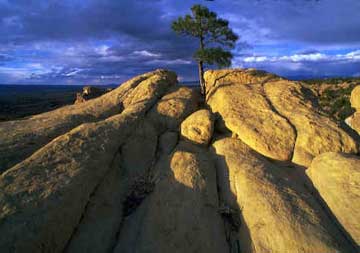
Bruce Scorsone
bscorsone@aol.com
Saginaw MI USA
Used a Nikon 8008S /w 20mmlens, Fuji Velvia @40 ISO.
Shot in New Mexico Near Grant. Sunset
Michael’s Critique
Warmly cross-lit rocks, a dramatic sky and a lone tree; all the ingredients needed for a successful landscape photograph and Bruce has carried it off well. There’s always a challenge with shots like this when done with a very wide-angle lens. That is, "where to put the horizon". Just a few inches higher or lower and the effect is very different.
I raise the question, but I don’t have an answer to offer. But, just visualize how this image would change if the horizon line was in a different place.
You can add your own comments on Bruce’s photograph on the Critique section of ourDiscussion Forum.
Michael Barnett
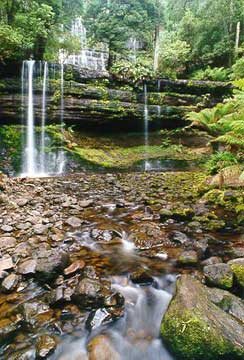
Michael Barnett
Melbourne, Australia
mikebear@netspace.net.au
Nikon F90s,Nikkor 28-70 3.5-4.5,Kodak Ektrapress 100,February 16, 1995
I arrived at Russell Falls in Mt Field National Park, Tasmania late inthe afternoon. As the sun was setting behind the falls I returned withcamera and tripod the next day to take pictures in the softer morninglight.Experimenting with exposure times I took a beautiful series of thefalls. This is one of my more pleasing photographs from the day.
Michael’s Critique
I’m a sucker for waterfalls, particularly ones as well photographed as this. This image cries out to be reproduced in a large size so that the detail can be enjoyed.
Michael has used just the right shutter speed to show the water at its best, and photographing in the diffused light of morning avoids the harsh shadows which direct sunlight would have caused. A lovely image.
You can add your own comments on Michael’s photograph on the Critique section of ourDiscussion Forum.
Lou Cohen

Lou Cohen
Holtsville, Long Island, NY
LOUCOH@AOL.COM
This is Antelope Canyon, in Arizona. Exposure was 1/60th @ F8, on Kodak Portra NC. Equipment was Nikon N80, with 50mm F1.8 lens.
I liked the way the walls of the canyon overlapped each other in this upward view, and some judicious use of the ‘burn’ tool in Photoshop accentuated that.
Michael’s Critique
Antelope Canyon never ceases to amaze. It has become an icon of contemporary landscape photography but its popularity doesn’t prevent photographers from making some striking images.
Lou has handled this particular shot well. It’s very easy to burn out the sky while trying to retain adequate shadow detail in the rock walls.
You can add your own comments on Lou’s photograph on the Critique section of ourDiscussion Forum.
Peter Johngren
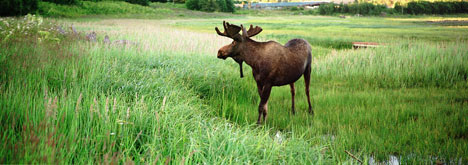
Peter Johngren
Hartwick, NY 13348 USA
pjohngren@stny.rr.com
Hasselblad Xpan
45mm lens
Fuji Superia 200
Scanned with a Nikon LS-20 film scanner. Imaged with Photoshop LE
This was right next to the town beach in Homer, Alaska, along a "nature walk". We were about 15 feet away from the moose, who seemed unconcerned.
Michael’s Critique
This photograph really makes me smile. I love the delicacy of the moose’s stance.
This type of "environmental wildlife" photograph, where the creature is seen in the context of its habitat, (inthe landscape, as it were) is very appealing.
I realize that it’s a grab-shot, but compositionally there are a few things wrong with it. The top of the frame is "messy". If the viewpoint had been just a little bit higher that would have solved it. Also, the bit of boardwalk that can be seen just to the right of the moose is distracting.
Finally, while the XPan’s wide aspect ratio is beneficial in placing the moose in context, the framing in this case is simplytoowide for the subject matter. I would crop the frame on both sides by about 25%, keeping the moose mostly to the right so that he’s still looking into the larger area of the frame.
You can add your o
Ed Leys
A thin frame has been used to separate the image from the black background (MR)
Ed Leys
temporarily: Antwerp, Belgium
eleys@meer.net
Technical details: taken with a Canon PowerShot A50 digital, cropped to it’s essence with PhotoShop, and e-mailed via my laptop from my hotel room in Antwerp. Isn’t electricity wonderful…
Taken a couple of days ago in the Flanders region of Belgium. Trees on farmland near Sint Niklaas.
Michael’s Critique
There’s much to be learned from this photograph. It is remarkably well seen. So many photographers regard the dimensions of their film or imager format as being sacrosanct. Instead it should bethe subject matterthat determines the photograph’s aspect ratio not the camera manufacturer.
We should all learn as well thatanycamera, even a three-generation old low-res digital point-and-shoot, is capable of taking powerful images in the hands of a photographer with a strong visual talent.
You can add your own comments on Ed’s photograph on the Critique section of ourDiscussion Forum.
Stuart L. Posner

Stuart L. Posner
Paradise Valley AZ 85253
Made during a trip to northern Montana late one afternoon in December. The mountain lion perched on a snow bank long enough for just on frame taken hand held with a Nikon 80-200 f2.8 zoom using compensated fill flash.
Michael’s Critique
It’s hard to believe that this photograph was taken in the wild, particularly with such a short focal length lens and with a fill flash at the ready.
Needless to say it’s been carried off perfectly. The brightly illuminated snow has become a reflector, creating a highly unusual lighting situation. The falling snow adds to the naturalness and the shallow depth of field totally isolates the mountain lion from the background. Stuart also managed to avoid cropping off the tail, something which could easily have happened in the heat of the moment, or, as it were, the cold of the moment. Beautifully done.
You can add your own comments on Stuart’s photograph on the Critique section of ourDiscussion Forum.
George Kmetz

George Kmetz
I am an amateur photographer, I became interested in photography when I joined the US Navy in 1969. This shot is of the Washington coast sea stacks at dusk, taken with a Nikon f3, Nikkor f4 25-50mm, tripod.
Michael’s Critique
This is a classic view of sea stacks, probably at sunset. George doesn’t say, or where it’s located‚ though likely the California coast. The photograph works well, and I like that he has caught the tide at just the right time to reflect the stacks in an incoming wave. A good photograph, but not a great one.
You can add your own comments on George’s photograph on the Critique section of ourDiscussion Forum.
Chris VenHaus

Chris VenHaus
WaukeshaWI
drmr@execpc.com
This picture was taken with a Canon A2E, Canon 35mm f2.0, Bogen tripod, and Fuji Astia. No filtration was used. Taken at Michigan U.P. The body of water in the background is Lake Michigan. My options were somewhat limited with this small marsh because there was garbage in the water to my right. Unfortunate.
Michael’s Critique
Pleasing, but ultimately unsatisfying. The sky is lovely and the reflection works, but the problem is that there is no compelling composition. It’s one of those shots that I’d have taken as well, but it would have been placed in the "B" pile. Whileprettyit lacks any mystery.
You can add your own comments on Chris’ photograph on the Critique section of ourDiscussion Forum.
Ronald Blachly
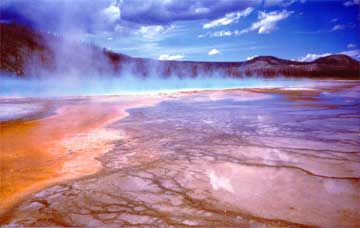
Photographer: Ronald Blachly, M.D.
City: Jonesboro, AR
Country: USA
email: theblach@swbell.net
Camera: Olympus Stylus
Film: Fuji Sensia
Description: I was traveling in Yellowstone, visiting the thermal and geyser areas one afternoon when I saw this scene. I had made a conscious decision to travel light without my SLR gear; I think this allowed me to see better.
Michael’s Critique
A good photograph of the thermal pools at Yellowstone. Goes to show, as we all know, that it isn’t the camera that makes the shot, it’s the photographer.
You can add your own comments on Ronald’s photograph on the Critique section of ourDiscussion Forum.
Paulo Bizarro

Paulo Bizarro
Carcavelos, Portugal
pbizarro@cggp.pt
This shot was taken in the northern part of Portugal, last May. Me and my 6 year old son were returning from the city of Bragança, when the clouds suddenly started to build up. I pulled up by the side of the road near this lonely tree, and had to work quickly, as heavy showers were forming. Tripod mounted Eos 1n, with 24mm lens, on Provia 100F. Exposure data unrecorded, though I am pretty sure it was f/16. I like the somber and menacing mood of the stormy sky, the isolation of the tree, and the patch of yellow flowers. I have a B&W shot taken at the same time with a GR1S, and I do like both.
Michael’s Critique
Paulo’s submission this month is another compelling image. The composition has a lot of tension, which compliments the ominous clouds and the starkness of the tree. Nicely done.
My only complaint is that the image is too contrasty, something that I see from many submitter’s scans.
You can add your own comments on Paulo’s photograph on the Critique section of ourDiscussion Forum.
John Riedy
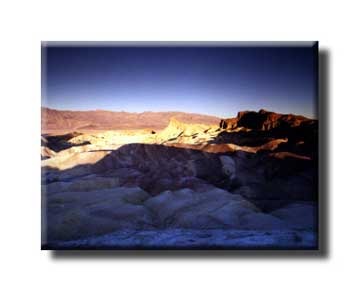
John Riedy
www.riedyphoto.com
This shot was taken on my honeymoon. Obviously, this is Zabriski Point in Death Valley, CA at sunrise. The moment was stunningly peaceful until a pack of German tourists converged upon the overlook. This was shot with a Bronica 645 on an 80mm lens with a N6 hard-edged grad. Exposure info was not noted.
Michael’s Critique
First, this type of presentation has become a cliché and is just too precious. Drop shadows were big in 1993 but rarely work these days. I believe that a photograph should be strong enough to stand on its own, with just a simple frame to separate it from the background.
As to the photograph, it leaves me uninvolved. The harsh contrasts don’t do anything for me. Sorry.
You can add your own comments on John’s photograph on the Critique section of ourDiscussion Forum.
Dennis McKenzie
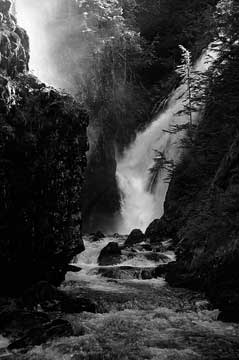
Photographer: Dennis McKenzie, Wasilla, Alaska. USA .djmckenzie@webtv.net
Technical data. Nikon f4s, with Nikon 24-120mm zoom, Provia F100 pushed to 200 iso. Handheld with monopod. Location; Knight Island, Prince William Sound, Alaska. Situation: With our sailboat anchored in a cove on Knight Island, my wife and I clawed, crawled, climbed, hacked and wadded our 50 year old plus bodies up a fast moving steeply inclined steam to find this "Hidden Falls". It took many hours of hard going to reach this spot. I was the only one to make it , due to her losing her monopod/walking staff in the white water. (we found it on our return) I went on using my Gitzo monopod and Kenises belt only, leaving the rifle and other gear with her. ( we have lots of bears here, I’m always armed in the Alaskan bush) The effort was well worth it this time. This powerful roaring falls which few have seen was the reward. The color slide was scanned into Photoshop and made into a B&W ( and then some dodging and burning and Photoshop stuff ) which captures my impressions of the power of the falls more than a color shot could do, at least for me.Michael’s Critique
This photograph carries a lot of drama. The lighting works, and the composition is very good. What I’m less happy about is the contrast. If Denniswantedthe presentation to be this contrasty, then so be it. I don’t care for it. If it’s the results of technical limitations in the taking or the digital processing then that’s a shame, because the photograph cries out for more detail and definition.
You can add your own comments on Dennis’ photograph on the Critique section of ourDiscussion Forum.
Steve Binkley
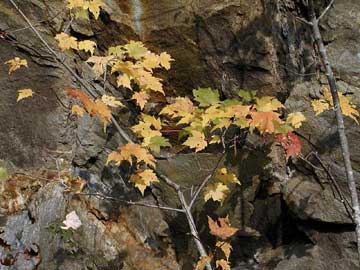
Photographer: Steve BinkleyCity / Country: Atlanta, GA, USAemail:sbinkley@mindspring.com Technical data: Olympus C-2100UZ digital camera, F6.3, 1/500, ISO 100, zoom at 99mm (35mm equivalent) This photo was taken 10/24/00 along the road to Brasstown Bald, Georgia. I was struck by the contrast of the delicate leaves against the stone.
Michael’s Critique
These types of photographs always are appealing, but that’s it. Everyone loves fall colour, and the contrast of yellow and orange leaves with textured brown bark. But, unless conveyed with some exceptional technical mastery (missing here) it’s little more than a snapshot.
You can add your own comments on Steve’s photograph on the Critique section of ourDiscussion Forum.
Perry Steinhoff
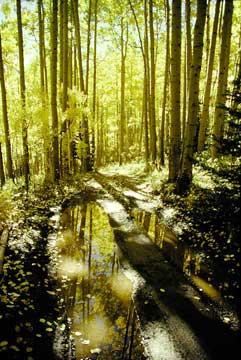
Perry Steinhoff
Colleyville, TX
http://www.steinhoffosta.com
E-mail: perry@steinhoffosta.com
The original photo was done in October 1978 on a forest road in the mountains near Ouray, in the San Juan Mountains of southwestern Colorado. I used an Olympus OM-2, using an Olympus 24-mm lens, and a tripod. I particularly enjoy the play of light and shadows in and around the puddles. I recently purchased a Nikon Coolpix 990, with which I am delighted. The enclosed photograph was taken with that magnificent machine in September 2000, of a 35-mm transparency (Kodachrome 25). To copy the slide, I used a copy stand with a standard light box, and the macro setting on the Coolpix. It is cropped full frame. The only alteration I made was in Photoshop, to slightly soften the grain of the ASA-25 film in the full-res version! The Nikon lens exhibits some pincushioning or barreling (depending on focal length), but it is nicely and effortlessly counteracted with Andromeda Software’s magical and inexpensive LensDoc plug-in for Photoshop.http://www.andromeda.com/info/lensdoc/
Michael’s Critique
This photograph has something to say. It’s about light and location. More than simply a record of what was in front of the camera, even the considerable distortions are interesting, though I feel like my feet are going to get wet as the pond water sloshes out of the frame. Vertical trees, tilted horizon. Hummm.
You can add your own comments on Perry’s photograph on the Critique section of ourDiscussion Forum.
Leon Wittwer

Leon Wittwer
Alexandria, VA
leewitt@attglobal.net
This panorama was taken from Desert View on the South Rim of the Grand Canyon looking to the northwest. The time was about 10:00 AM in late June, 2000. The shots making up the final image were taken by a Kodak DC 290 digital camera using autoexposure for the first shot and exposure lock for the remainder. Approximately a dozen shots were used. Adobe Photoshop was used to construct the panorama. The original photograph before downsizing was 5712×1678 pixels. This panorama is typical of the large images that I like to do. I have done many in northern Arizona and southern Utah.
Michael’s Critique
Leon’s photograph is a technically well executed image of a great subject. It has one fatal flaw though. The light is terribly boring. Overhead, harsh and completely lacking in character. Consequently this becomes nothing more than a photographic record of the physical location.
Good photography takes work. This means showing up at dawn, sunset, foggy days, after storms‚ whenever the light is doing something special. Showing up at noon doesn’t count. Mid-day is for traveling between locations.
See the submission immediately below to see what I mean.
You can add your own comments on Leon’s photograph on the Critique section of ourDiscussion Forum.
Scott Laughlin

Nikon N90s, Nikon 80-200 f2.8 at 200mm. Fuji Velvia was used and a 1 stop
ND grad. F11 at 1/60.
This shot was taken on a very cold March morning Door County, Wisconsin. I set up early hoping to get a good shot of a lighthouse illuminated by the rising sun. As I waited trying to stay warm, I glanced over the horizon to watch the position of the sun. This image presented itself and I quickly spun the camera around to catch it. The water collecting in the rocks reflecting the colors of the sunrise is what got my attention. The colors are as they were seen, although the ND filter was still not enough to get the grey in the rocks. The only digital alterations were cropping.
Michael’s Critique
An attractive sunrise, but no cigar. There is too much darkness and high contrast for my taste, and I’d have wanted some more colour in the reflection. A different angle would have helped. The colour of the sky is also a bit over-the-top Velviaish.
You can add your own comments on Scott’s photograph on the Critique section of ourDiscussion Forum.
Mark Gourley

This is wine country, and a winery can be seen to the bottom right, across the river on the other side is forestry. A shot taken about 8am in the morning.Camera – Minolta 9xi , Lens 35-105 f2.8E-mail –
Michael’s Critique
A lovely pastoral scene. The cloud over the dip in the horizon is the touch that lifts it above just being a postcard. I find the abundance of sky to be troublesome, but that’s debatable. Quite appealing.
You can add your own comments on Mark’s photograph on the Critique section of ourDiscussion Forum.
Attila Kirjak
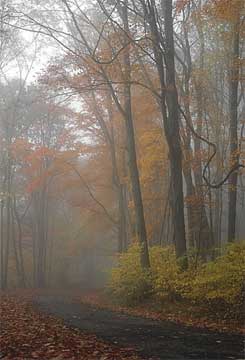
Attila Kirjak
New York
kiru@mailzone.com
http://www.mailzone.com/~kiru
This picture was taken next to the Delaware river, early morning fog was rising from the river, on this October morning.
Canon EF 50mm f1.8 lens, 1/8 sec at f16, Evaluative metering +0.3 overexposure, no filter, tripod, on Provia 100F.
Michael’s Critique
An appealing, well composed, well exposed image. I find though that the branch coming out of the central right part of the frame and snaking upward is a serious distraction. At first I thought that it was a hair on the film! Too bad.
You can add your own comments on Attila’s photograph on the Critique section of ourDiscussion Forum.
Michael Seif
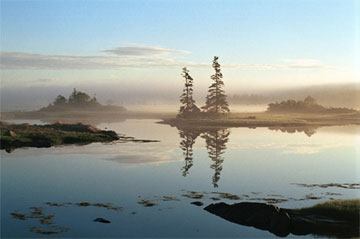
Michael SeifWatertown, Massachusetts, USA
Michael’s Critique
An almost perfect landscape photograph. Light and subject are in harmony and atmospherics are dramatic. Michael has the formula.
I’d be tempted to crop it to a panoramic, losing the bottom rocks and a bit of sky, but that’s just me. A first rate image!
You can add your own comments on Michael’s photograph on the Critique section of ourDiscussion Forum.
Andrew Scheinman
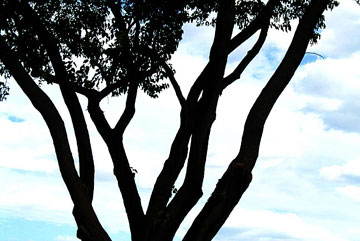
Andrew Scheinman
Urbana, Illinois. USA
scheinmana@aol.com
Camera Kodak DC290
I took this photo at midday in Arizona. The tree was in the middle of a rundown town at the edge of a dropoff with pure Arizona sky behind it. Looking at it I was struck by the abstract shape of the tree and the sky, which always seems to be incredible in Arizona and New Mexico.
Michael’s Critique
We all like taking this type of silhouette. The simplicity is appealing. But frankly these images are so familiar and commonplace that another one has to really stand above the crowd to work. This one doesn’t quite.
You can add your own comments on Andrew’s photograph on the Critique section of ourDiscussion Forum.
You May Also Enjoy...
Cottonwood_Cove_site_1
Hozógo nasádo.© Miles HeckerCLICK ABOVE IMAGE TO SEE GOOGLE MAP LOCATIONSEASONS The Coyote Buttes area is typical of the high southwestern desert. Summer temperatures often
Cinematography for Photographers – Promo
Luminous Landscape's Michael Reichmann & Christopher Sandersondiscuss some of the techniques required by photographers to successfully use the video capability of modern still cameras.
